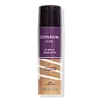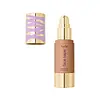What's inside
What's inside
 Key Ingredients
Key Ingredients

 Benefits
Benefits

 Concerns
Concerns

 Ingredients Side-by-side
Ingredients Side-by-side

Cyclopentasiloxane
EmollientWater
Skin ConditioningGlycerin
HumectantDimethicone Crosspolymer
Emulsion StabilisingSodium Chloride
MaskingAcetyl Glucosamine
Skin ConditioningDiethylhexyl Carbonate
EmollientNiacinamide
SmoothingEthylhexyl Methoxycinnamate
UV AbsorberTalc
AbrasivePEG/PPG-18/18 Dimethicone
EmulsifyingPanthenol
Skin ConditioningPalmitoyl Pentapeptide-4
Skin ConditioningTocopheryl Acetate
AntioxidantAllantoin
Skin ConditioningMethicone
EmollientAluminum Hydroxide
EmollientBenzyl Alcohol
PerfumingCamellia Sinensis Leaf Extract
AntimicrobialPEG-10 Dimethicone Crosspolymer
StabilisingMethylparaben
PreservativeEthylparaben
PreservativePropylparaben
PreservativeDisodium EDTA
Parfum
MaskingPEG-100 Stearate
Titanium Dioxide
Cosmetic ColorantIron Oxides
Cyclopentasiloxane, Water, Glycerin, Dimethicone Crosspolymer, Sodium Chloride, Acetyl Glucosamine, Diethylhexyl Carbonate, Niacinamide, Ethylhexyl Methoxycinnamate, Talc, PEG/PPG-18/18 Dimethicone, Panthenol, Palmitoyl Pentapeptide-4, Tocopheryl Acetate, Allantoin, Methicone, Aluminum Hydroxide, Benzyl Alcohol, Camellia Sinensis Leaf Extract, PEG-10 Dimethicone Crosspolymer, Methylparaben, Ethylparaben, Propylparaben, Disodium EDTA, Parfum, PEG-100 Stearate, Titanium Dioxide, Iron Oxides
Water
Skin ConditioningCyclopentasiloxane
EmollientMethyl Methacrylate Crosspolymer
Phenyl Trimethicone
Skin ConditioningButylene Glycol
HumectantCyclohexasiloxane
EmollientCaprylyl Methicone
Skin ConditioningGlycerin
HumectantPEG-10 Dimethicone
Skin ConditioningTrimethylsiloxysilicate
EmollientCyclomethicone
EmollientSorbitan Isostearate
EmulsifyingSodium Chloride
MaskingCetyl PEG/PPG-10/1 Dimethicone
EmulsifyingTriethyl Citrate
MaskingDisteardimonium Hectorite
StabilisingAluminum Hydroxide
EmollientPhenoxyethanol
PreservativeDimethicone Crosspolymer
Emulsion StabilisingTriethoxycaprylylsilane
Parfum
MaskingEthylhexylglycerin
Skin ConditioningDisodium EDTA
Benzyl Salicylate
PerfumingHexyl Cinnamal
PerfumingLimonene
PerfumingHydroxycitronellal
PerfumingGeraniol
PerfumingAmyl Cinnamal
PerfumingLinalool
PerfumingPyrus Malus Fruit Extract
Skin Conditioning1,2-Hexanediol
Skin ConditioningTremella Fuciformis Extract
HumectantHyaluronic Acid
HumectantHydrolyzed Hyaluronic Acid
HumectantSodium Hyaluronate
HumectantIron Oxides
CI 77891
Cosmetic ColorantWater, Cyclopentasiloxane, Methyl Methacrylate Crosspolymer, Phenyl Trimethicone, Butylene Glycol, Cyclohexasiloxane, Caprylyl Methicone, Glycerin, PEG-10 Dimethicone, Trimethylsiloxysilicate, Cyclomethicone, Sorbitan Isostearate, Sodium Chloride, Cetyl PEG/PPG-10/1 Dimethicone, Triethyl Citrate, Disteardimonium Hectorite, Aluminum Hydroxide, Phenoxyethanol, Dimethicone Crosspolymer, Triethoxycaprylylsilane, Parfum, Ethylhexylglycerin, Disodium EDTA, Benzyl Salicylate, Hexyl Cinnamal, Limonene, Hydroxycitronellal, Geraniol, Amyl Cinnamal, Linalool, Pyrus Malus Fruit Extract, 1,2-Hexanediol, Tremella Fuciformis Extract, Hyaluronic Acid, Hydrolyzed Hyaluronic Acid, Sodium Hyaluronate, Iron Oxides, CI 77891
Ingredients Explained
These ingredients are found in both products.
Ingredients higher up in an ingredient list are typically present in a larger amount.
Aluminum Hydroxide is a form of aluminum. It can be naturally found in nature as the mineral gibbsite. In cosmetics, Aluminum Hydroxide is used as a colorant, pH adjuster, and absorbent.
As a colorant, Aluminum Hydroxide may add opacity, or reduce the transparency. Aluminum hydroxide is contains both basic and acidic properties.
According to manufacturers, this ingredient is an emollient and humectant. This means it helps hydrate the skin.
In medicine, this ingredient is used to help relieve heartburn and help heal ulcers.
There is currently no credible scientific evidence linking aluminum hydroxide in cosmetics to increased cancer risk.
Major health organizations allow the use of aluminum hydroxide in personal care products and have not flagged it as a carcinogenic risk at typical usage levels.
Learn more about Aluminum HydroxideCyclopentasiloxane, or D5, is a silicone used to improve texture of products and trap moisture.
D5 is considered lightweight and volatile. Volatile means it evaporates quickly after application. Once evaporated, D5 leaves a thin barrier that helps keep skin hydrated.
It is also an emollient. Emollients help soften the skin and prevent water loss. Silicones create a silky texture in products. D5 helps other ingredients become more spreadable.
Studies show D5 is safe to use in skincare products. We recommend speaking with a skincare professional if you have concerns.
Learn more about CyclopentasiloxaneDimethicone Crosspolymer is a silicone created by modifying dimethicone with hydrocarbon side chains. Due to its large size, it does not penetrate skin. It is considered non-occlusive.
Dimethicone Crosspolymer is used to stabilize and thicken products. It also helps give products a silky feel.
Disodium EDTA plays a role in making products more stable by aiding other preservatives.
It is a chelating agent, meaning it neutralizes metal ions that may be found in a product.
Disodium EDTA is a salt of edetic acid and is found to be safe in cosmetic ingredients.
Learn more about Disodium EDTAGlycerin is already naturally found in your skin. It helps moisturize and protect your skin.
A study from 2016 found glycerin to be more effective as a humectant than AHAs and hyaluronic acid.
As a humectant, it helps the skin stay hydrated by pulling moisture to your skin. The low molecular weight of glycerin allows it to pull moisture into the deeper layers of your skin.
Hydrated skin improves your skin barrier; Your skin barrier helps protect against irritants and bacteria.
Glycerin has also been found to have antimicrobial and antiviral properties. Due to these properties, glycerin is often used in wound and burn treatments.
In cosmetics, glycerin is usually derived from plants such as soybean or palm. However, it can also be sourced from animals, such as tallow or animal fat.
This ingredient is organic, colorless, odorless, and non-toxic.
Glycerin is the name for this ingredient in American English. British English uses Glycerol/Glycerine.
Learn more about GlycerinParfum is a catch-all term for an ingredient or more that is used to give a scent to products.
Also called "fragrance", this ingredient can be a blend of hundreds of chemicals or plant oils. This means every product with "fragrance" or "parfum" in the ingredients list is a different mixture.
For instance, Habanolide is a proprietary trade name for a specific aroma chemical. When used as a fragrance ingredient in cosmetics, most aroma chemicals fall under the broad labeling category of “FRAGRANCE” or “PARFUM” according to EU and US regulations.
The term 'parfum' or 'fragrance' is not regulated in many countries. In many cases, it is up to the brand to define this term.
For instance, many brands choose to label themselves as "fragrance-free" because they are not using synthetic fragrances. However, their products may still contain ingredients such as essential oils that are considered a fragrance by INCI standards.
One example is Calendula flower extract. Calendula is an essential oil that still imparts a scent or 'fragrance'.
Depending on the blend, the ingredients in the mixture can cause allergies and sensitivities on the skin. Some ingredients that are known EU allergens include linalool and citronellol.
Parfum can also be used to mask or cover an unpleasant scent.
The bottom line is: not all fragrances/parfum/ingredients are created equally. If you are worried about fragrances, we recommend taking a closer look at an ingredient. And of course, we always recommend speaking with a professional.
Learn more about ParfumChances are, you eat sodium chloride every day. Sodium Chloride is also known as table salt.
This ingredient has many purposes in skincare: thickener, emulsifier, and exfoliator.
You'll most likely find this ingredient in cleansers where it is used to create a gel-like texture. As an emulsifier, it also prevents ingredients from separating.
There is much debate on whether this ingredient is comedogenic. The short answer - comedogenic ratings don't tell the whole story. Learn more about comegodenic ratings here.
The concensus about this ingredient causing acne seems to be divided. Research is needed to understand if this ingredient does cause acne.
Scrubs may use salt as the primary exfoliating ingredient.
Learn more about Sodium ChlorideWater. It's the most common cosmetic ingredient of all. You'll usually see it at the top of ingredient lists, meaning that it makes up the largest part of the product.
So why is it so popular? Water most often acts as a solvent - this means that it helps dissolve other ingredients into the formulation.
You'll also recognize water as that liquid we all need to stay alive. If you see this, drink a glass of water. Stay hydrated!
Learn more about WaterThis ingredient is a combination of red, black, and yellow iron oxide pigments. This combination of colors is usually found in foundation, because it results in a "skin" color.